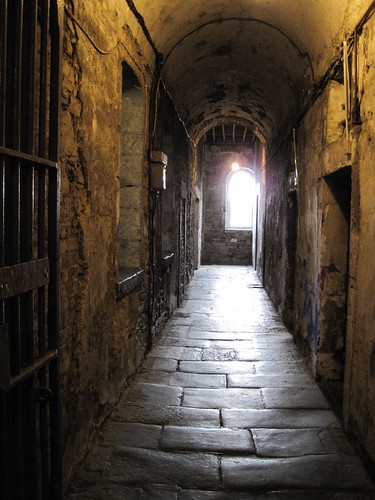5/30/10
More than anything else in Dublin, I think I was looking forward to the Kilmainham Gaol tour the most. I honestly can’t explain why. What part of an 18th-century jail where most of the Irish Rebellion’s leaders were executed sounds appealing? Oh wait – all of them!
As our tour guide Dónal told us, the British government opened the jail in 1796 for all types of crimes up until 1914, when it was used mainly for political prisoners until its closing in 1924. The other main period was Ireland’s potato famine period from roughly 1845 to 1850. Originally meant for 200 people, the jail could house five to six times that by cramming multiple prisoners into a single drab cell. Most people, however, chose to be here and would put up with the cold and cramped spaces to be guaranteed food, instead of live for free on the outside where food was hard to come by. The guide specifically mentioned a trio of boys who stole four loaves of bread just to get locked up.
Dónal told of an interesting story about death-row inmate Joseph Plunkett, a key figure in Ireland’s 1916 Easter Rising – which won the country independence from British rule – and his wife Grace Gifford. The afternoon they were married at the jail, Gifford went to her new husband’s cell for 10 minutes. Every minute, security guards came by. Finally, they escorted Gifford out of the room and out the front door, where she heard the shots from the firing squad that ended Plunkett’s life.
The tour moved to a room that was a condemned cell, where prisoners stayed under watch until they could be hanged. They were watched because in those times, a public hanging was entertainment and officials didn’t want the public to go without a show. Dónal told a story about Robert Emmet, who in 1803 tried to lead a rebellion against the British. (As one of our tour guides throughout the trip – I think it was John from the ghost walk – pointed out, the Irish liked to hold rebellions every few years.)
Emmet’s idea was apparently brilliant on paper, but flopped big time and is said to have only lasted an hour. For his mistake, he was sentenced to be hanged from the gallows, whose support holes can be seen above the doorway leading into where we got our tickets. Not only was poor Emmet hanged in front of a crowd, but he was beheaded as well. Apparently this was because Emmet was well off and the British wanted to make an example that anybody, no matter their status, could be executed.
Stories about its prisoners aside, the jail itself was very daunting. The walls were made of stone, and inside the cells were all white. Opening the thick black door of the cell gave way to wooden floors. Dónal pointed out that all of the rooms in at least the newer east wing had windows that faced up to heaven. He didn’t mention this in the older west wing, so I’m not sure if it is true for every single cell. The closest I’ve ever gotten to being inside a jail is MSNBC’s Lockdown with John Siegenthaler, so I’ve never heard anything about this type of symbolism before.
Prisoners were given one candle every two weeks, so they had to be wise when using their heat or light. They later updated this to a gas system, but the gas was only turned on for about an hour or two a day. The jail corridor we were in was pretty chilly, but Dónal pointed out that it was even colder when there weren’t any windows in the place. They were just openings without glass.
I’m really glad I was able to see inside the jail. A lot of Irish history seems grim and almost bathed in blood, but so has been the history of a lot of countries. It was a very odd feeling standing on and walking around the same grounds that revered Irish revolutionaries were once incarcerated. Overall, I am very pleased with my choice to have gone on this tour and would recommend it to anybody.



